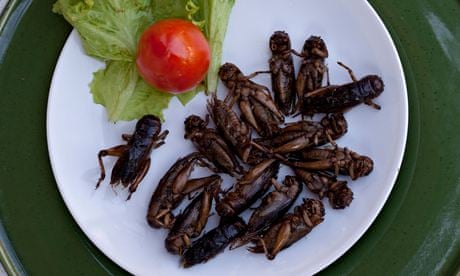Students are known for their terrible eating habits, but few have diets as strange as Peter Bickerton, whose recipes for homemade locust burgers and waxworm tacos have been translated into Italian, Indonesian and Arabic as they do the rounds on the internet.
Bickerton has become famous as the guy who eats bugs, but this is no party trick – Bickerton began eating insects after a serious health scare in his family.
"My uncle died of a heart attack when he was 45, and then three months later my other uncle, Michael, had triple bypass heart surgery," says Bickerton.
A family history of heart disease put Bickerton at an increased risk of the condition, which is related to high levels of cholesterol. After his mother discovered that she too had high cholesterol, she started taking statins. But Peter decided to try something different.
Bickerton, a PhD student in plant sciences, started reading about the nutritional value of insects. He discovered that insects were high in protein, contained less saturated fat than other meats and were more environmentally friendly to produce than beef, lamb and pork.
"Insects are extremely efficient at converting feed to body weight," says Arnold van Huis, professor of entomology and lead author of Edible Insects (pdf), a report by the UN Food and Agriculture Agency released last year. "If you take a cricket for example, it only takes 2.1kg of feed to produce 1kg of edible body weight. To produce one kilogram of beef, you need 25kg of feed."
It's this staggeringly efficient conversion that makes the UN want to put insects on the menu. By 2050, the world population is expected to rise to 9 billion, to feed all these new arrivals, we will need to produce nearly twice as much food as we do today.
Insects are already part of the diets of 2 billion people worldwide: crispy fried beetles are a common street food in Thailand, caterpillars are a popular snack in sub-Saharan Africa, and grasshoppers are fried in garlic and eaten in parts of Mexico. But in the west, the idea of eating insects fills us with disgust; they are fed to squirming celebrities on our reality TV shows.
Our disgust reaction protects us from things that might carry parasites and disease, according to "disgustologist" Valerie Curtis, an expert on hygiene and behaviour at the London School of Hygiene and Tropical Medicine. "Humans have a rule of thumb, which is only ever eat what your mother feeds you," says Curtis. Disgust, like culture, is passed down from generation to generation.
And it can be a powerful thing. While it may have evolved as a way to avoid disease, disgust can guide our manners and behaviour, and even our politics. "Many issues like flag burning or sexual violations stimulate disgust," says Paul Rozin, professor of psychology at the University of Pennsylvania, who is working on the psychology of resistance to eating insects.
Despite its power over our lives, there are ways to overcome disgust. If we were entirely governed by it, we would never try new things. Changing the eating habits of billions of people, however, is quite a challenge. After all, getting people to try something that they find disgusting is hard enough, let alone a whole culture.
But it has happened before. Lobster used to be so abundant along the east coast of the US and Canada that it was seen as a poor man's food. "Lobster shells about a house are looked upon as signs of poverty," wrote John J Rowan in 1876 after a trip to Nova Scotia. Today, lobsters are often the most expensive item on the menu.
"One way food transitions take place is that food comes to be labelled very high-status," explains Curtis. "Maybe if insects could become precious delicacies, and sold as something incredibly expensive, it would then percolate its way through society."
Which brings us to east London. In March, a pop-up food restaurant called Grub served up insects in Hoxton Square for one week only. The food was prepared by a Thai chef, and the menu boasted dishes such as curried beer tempura grasshoppers. Grub's founder, Shami Radia, says that while sustainability is important to him, he knows he's not going to sell the food on its environmental credentials alone. "It doesn't matter how sustainable it is, if it doesn't taste good, no one's going to eat it," he says.
Reviews of the food were positive, and the price was high at £36.50 a head. "The thing I enjoy the most is watching someone that hasn't eaten insects before. When they take a bite, their facial expressions change from real dread, to a little bit of surprise, and then to delight," says Radia.
Maybe to convince the world to eat insects, a bit of reverse psychology needs to be employed. Like their distant cousins the lobster, if insects were prepared by elite chefs and consumed by the super-rich, then maybe we'd all want a slice of the locust pie.
Jack Millner is a freelance science and technology journalist published in the New Scientist, CNN and the Huffington Post.
The food hub is funded by the Irish Food Board. All content is editorially independent except for pieces labelled advertisement feature. Find out more here.
Join the community of sustainability professionals and experts. Become a GSB member to get more stories like this direct to your inbox

Comments (…)
Sign in or create your Guardian account to join the discussion